Take Years to Walk Again After a Stroke
If you lot struggle with walking after stroke, rehabilitation can help you go dorsum on your feet with confidence again. Your manner of walking, also known as your gait, can often be recovered later a stroke, at least partially if not fully, by customizing a consequent rehabilitation program to your unique needs and abilities. This article volition explain everything you need to know to get started.
We have updated this article to be detailed and comprehensive. At that place's a lot of data in hither, then bookmark this extensive article and use the links below to jump straight to any department:
Tabular array of contents
- Why does walking become difficult later on stroke?
- How gait rehabilitation works
- Recovering gait after post-stroke paralysis
- Walking exercises for stroke patients
- Devices to assist stroke survivors walk
- Other tips for gait rehabilitation subsequently stroke
- What are the chances of walking subsequently a stroke?
- How long does it have to walk again after a stroke?
Why Does Walking Get Hard Afterward Stroke?
Stroke is the leading cause of disability in America. It occurs when the supply of blood in the brain is compromised, depriving encephalon cells of oxygen and subsequently causing brain tissue damage.
Secondary effects of stroke vary greatly based on which areas of the brain sustained damage. These effects tin include changes in cognitive skills, motor abilities, sensation, vision, advice, and personality. When gross motor skills (large movements of the torso, leg, and/or arm) are affected every bit the event of a stroke, it can impact your gait.
Motor difficulties afterwards a stroke often bear on just one side of the body, which can cause balance problems that further disrupt your gait. This is because each hemisphere of the encephalon controls movement on the opposite side of the body, and a stroke oftentimes affects one hemisphere, not both. (All the same, multiple strokes on both sides of the brain are possible.)
Therefore a right hemisphere stroke may cause difficulty with motion on the left side of the torso and a left hemisphere stroke may affect the right side of the body. This is why hemiparesis and hemiplegia, ii conditions that affect move on one side of the body, are common secondary furnishings of a stroke.
Hemiparesis involves weakness on ane side the body while hemiplegia, the more severe status, involves paralysis on 1 side of the body. Hemiplegia may affect but half of the face, an arm, or a leg; but well-nigh commonly it affects ane unabridged side of the torso.
The amount of weakness or paralysis varies from person to person considering every stroke is different. Fortunately, recovery is possible for the majority of individuals, even those with hemiplegia/postal service-stroke paralysis. Next, you'll discover how it works.
How Gait Rehabilitation Works
Rehabilitation is fundamental to regaining the power to walk after stroke. It works past stimulating the brain with various physical therapy exercises and activities. A physical therapist is an splendid resource for gait recovery every bit they are specially trained in helping people restore movement.
Later on a stroke, patients are typically sent to an inpatient rehabilitation center where they participate in multiple hours of one or more types of therapy per day. During physical therapy, your therapist volition guide you lot through various exercises and activities with the goals of restoring motion and coordination, strengthening the muscles, and retraining the brain.
Retraining the brain is arguably the most important aspect of gait rehabilitation after stroke. The brain rewires itself through a phenomenon known as neuroplasticity, which is how all skills are learned or re-learned. Neuroplasticity helps your brain become more efficient with the tasks that you do regularly by strengthening neural pathways.
For example, when first learning to ride a cycle, information technology's difficult because information technology'due south new and your brain has not yet established efficient neural pathways for the task. But each time you practice, your encephalon forms and strengthens its pathways. At first, your pedaling may be awkward, only the more y'all practice, the smoother your movements go every bit the brain adapts.
The same concept applies to gait rehabilitation: practice makes perfect. Re-learning to walk after stroke is all about practice. By repeating physical therapy exercises on a consistent footing, y'all will aid rewire your brain and improve your gait.
Recovering Gait After Post-Stroke Paralysis
But what if you can't practise in a conventional way because of hemiplegia/post-stroke paralysis? This is where passive exercise and therapeutic modalities can help.
Passive exercise involves assisting your afflicted limbs through an practice, either past using your not-afflicted side or receiving help from a trained caregiver or therapist. Although the movement is washed for you, it helps stimulate the brain and spark neuroplasticity, especially when attention is paid to the movement.
Every time you lot move your afflicted side through therapeutic movements, and y'all bring this movement into your awareness, you assist stimulate the brain and create positive changes. Results volition come slowly – you may see muscle twitches initially as your movement abilities return – and that's a sign of progress.
Understanding the deviation between active exercise and passive exercise is important when customizing a rehabilitation program to your unique needs.
A concrete therapist may also utilize different treatment options, such as electrical stimulation (e-stim), to retrain the brain to activate the muscles needed for walking. E-stim involves placing electrodes on the skin and using an electrical electric current to stimulate the muscles to contract. Once more, it tends to exist well-nigh effective when purposefully focusing on the movement.
Now that you empathise how rehabilitation works, permit'southward swoop into the walking exercises.
Walking Exercises for Stroke Patients
Physical therapy exercises are the best mode to improve your gait afterwards a stroke. Your physical therapist tin can recommend some appropriate exercises for you based on your power level.
Hither are some instance gait training exercises that your PT may recommend to assistance ameliorate your ability to walk:
Leg exercises
When we think of walking, we often think of our legs. While in that location is much more that goes into your gait, targeting your legs is a great place to first. Ask your PT for exercises that help with walking and (south)he will likely recommend some leg exercises along with a mix of others.
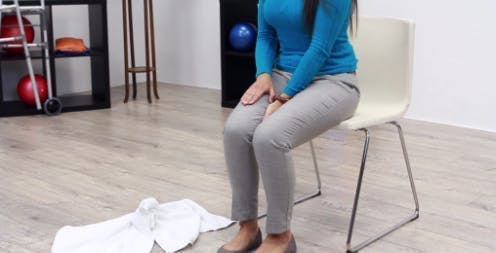
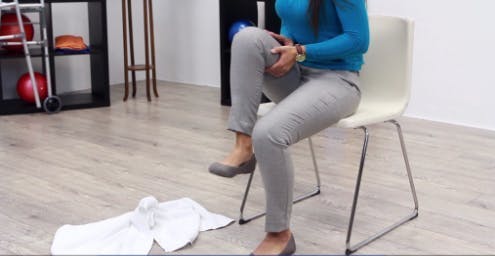
A helpful leg exercise to brainstorm with for gait rehabilitation isseated marching. From a seated position, lift your thigh up into your chest. If necessary, you tin can use your artillery to assistance with this movement. (This turns the movement into active assisted or passive practise for individuals with hemiplegia or astringent hemiparesis.) Adding an ankle weight tin can make this more than hard for those who are ready to focus on increasing strength and muscular endurance.
See all leg exercises for stroke patients »
Balance and core rehabilitation exercises
A stiff core is essential for maintaining balance while you walk and preventing falls. Along with your leg exercises, incorporate core and balance exercises that target your trunk too.
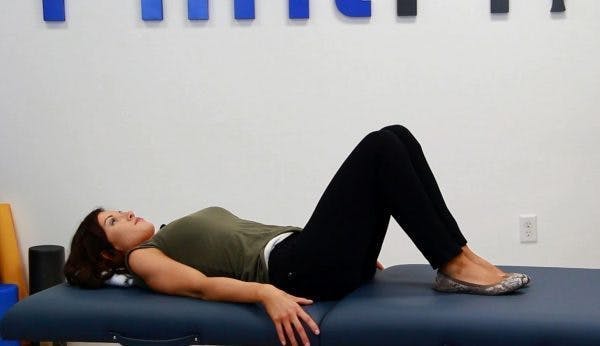
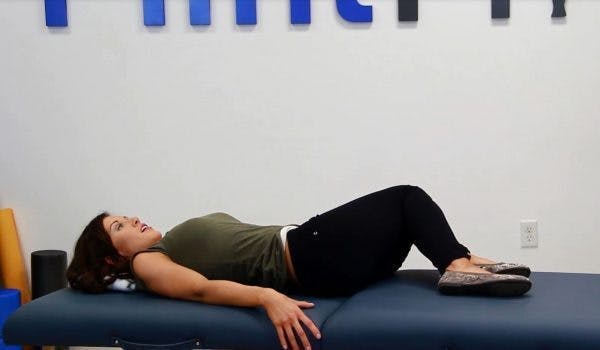
One example isleg rotation (which, despite its name, focuses more on your core more your legs). Start by lying on your back with your legs bent at 90 degrees. Then, let your legs fall to one side while trying your best to control the movement from your core.
Over again, if you cannot do this movement independently, ask a trained caregiver or therapist for assistance to make the exercise passive. All movement is beneficial and helps rewire the brain.
Run across all cadre exercises for stroke patients »
Foot driblet exercises
Pes drib is a post-stroke status that can make it difficult to lift the front office of your foot up — a movement known as dorsiflexion. This motion is critical for the power to walk safely and reducing the run a risk of tripping and falling.
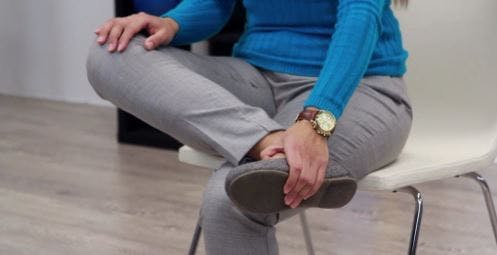
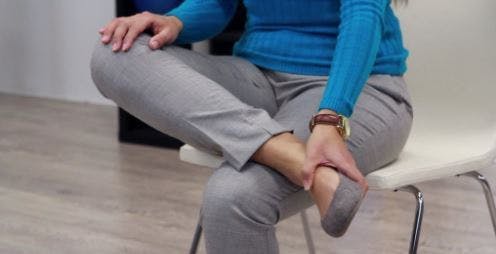
A good exercise for human foot drop is ankle dorsiflexion. Cross your afflicted leg over your thigh and hold your foot in your hand. And so, assistance your foot through dorsiflexion by moving the top of your foot dorsum toward your shin and and then back down. This can be done passively with help until you can practice information technology actively with no assistance.
See all human foot driblet exercises »
Devices to Assist Stroke Survivors Walk
Your physical therapist will recommend an advisable walking device for yous as needed.
Walking devices that are used following a stroke tin can vary greatly depending on your skills. They include front-wheeled walkers, platform walkers, hemi walkers, four-wheeled walkers, quad canes, and single bespeak canes. Over time, your physical therapist may try to help yous to transition to less stable walking devices, until you are able to walk without one at all.
It's important to use whatever walking device your therapist recommends and too practice rehabilitation exercises consistently.
Following forth to written sheets of exercises tin can exist tough due to low accountability and potential boredom. If you struggle with motivation to practice, then information technology can exist worth exploring exercise devices to help you stick with a dwelling house therapy program and encounter meliorate results.
Hither are some practice devices and machines that help ameliorate your ability to walk after stroke:
Assistive treadmills
Assistive treadmills aid back up your body while you practice walking. These devices are very expensive and ordinarily offered at rehabilitation facilities. Due to their high cost, information technology's frequently best to take advantage of these resources while insurance still covers therapy and explore other, more-affordable devices that you tin use at domicile.
NuStep
The NuStep is a blazon of recumbent cantankerous-trainer ofttimes used in rehabilitation clinics for individuals following a stroke. It allows you to sit while moving both your artillery and legs forward and dorsum, alternating sides, in a gentle gliding motion to activate muscles commonly used during walking. Again, these are rather expensive and therefore often best to apply during physical therapy sessions.
Stationary Bikes
A skillful device for recovering your gait at abode is a stationary wheel. These devices aid with gait recovery by targeting your legs through bilateral movement: when both limbs are used in unison to contract the muscles.
This is peculiarly appealing for individuals with hemiplegia or severe hemiparesis considering you lot can use your non-affected side to assistance your affected side, which helps encourage neuroplasticity.
Stationary bikes primarily target your legs and cadre, then it's important to combine it with other rehabilitation methods to target the total body.
FitMi habitation therapy
There aren't many affordable habitation rehabilitation devices that are both motivating and target the total trunk. This is why we created FitMi abode therapy, a rehab device that turns your physical therapy exercises into an interactive feel. It'south like having a virtual therapist available right from your computer.
In the image below, you lot can run across a stroke survivor doing leg exercises with FitMi (past stepping on the motility-sensing "pucks" beneath his feet) while following along on the computer.
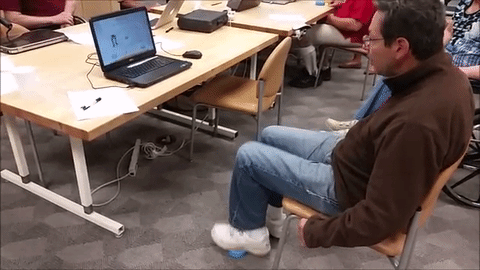
Many patients have improved their gait by using FitMi consistently at dwelling. Meet what other survivors have said about information technology:
"After suffering from a left side hemorrhagic stroke, I have been using the FitMi for iv months in conjunction with physical therapy and it actually has helped. I started with 0 mobility on right side and tin now walk without a pikestaff. You lot actually accept to put in the work merely you should meet results." –Dwayne, stroke survivor
"I have noticed existent-globe results from using FitMi. For one, I drive one-footed at present rather than two-footed because I can target the gas pedal and the brake with my right foot. I can target the cruise command fix button with my right hand. These accomplishments are due to the exercises and feedback of the FitMi." –Ronald, stroke survivor
FitMi encourages you to accomplish high repetition of therapeutic exercises, which helps spark neuroplasticity and rewire the brain. When y'all apply information technology consistently, you lot'll see the best results — like Dwayne and Ronald. You can read more FitMi reviews here.
Job-specific preparation
One time you are able to walk with assistance, you can start doing task-specific training, which involves directly practicing the skill you desire to get better at: walking! The more you walk, the better your gait will become.
Endeavor to walk as much as y'all can – making sure to utilise any equipment recommended by your therapist, such as a walker or cane – without overexercising. Pushing yourself too hard can crusade other complications such as post-stroke fatigue. Aim for your practice to aid you feel challenged only not exhausted.
Also, every bit yous explore your ability to walk with less assist, be extremely conscientious and do so in the presence of a caregiver or therapist to help prevent any tripping or falling. Falling afterwards stroke could result in further reduced mobility and setbacks, so accept all the precautions y'all tin can to avoid it.
Other Tips for Gait Rehabilitation After Stroke
Of grade, there's more than that goes into your gait than just muscle movement. Your vision also deserves attention if you want to improve your ability to walk later on stroke.
If you have vision bug, it will negatively impact your ability to walk safely. Your vision is important for navigating the earth around you and preventing falls.
Optometrists, neurologists, occupational therapists, and speech communication-language pathologists are all great resource for improving vision afterward stroke.
Your therapist or spoken communication-language pathologist tin besides screen you for a condition called hemineglect, which tin cause stroke survivors to be completely unaware of their affected side. This status must as well exist addressed earlier patients can safely walk again after stroke.
Now that you know what goes into gait rehabilitation, let's look at some statistics about potential recovery chances and timelines.
What Are the Chances of Walking After a Stroke?
Survivors are thought to accept a good chance of regaining the ability to walk within 6 months after stroke if they have the ability to sit and balance independently and the ability to contract the muscles of the talocrural joint, knee, and hip.
A study from 2015 found that hemiplegic patients had a 93.8% chance of achieving contained gait within vi months if could demonstrate these ii abilities in the first 72 hours after stroke.
This does not hateful that you cannot recover your power to walk if are unable to achieve these movements. It just means that rehabilitation may require more than effort and hard work through long-term rehabilitation and home exercises.
How Long Does It Take To Walk Again Later A Stroke?
Most patients regain the ability to walk within the first half dozen months or, when mobility has been severely afflicted, within the first 2 years following their stroke. Experts can agree that the chances of recovering role after stroke increase with the intensity of rehabilitation.
Nonetheless, recovery does not happen on its own. It requires consistent, long-term rehabilitation. For instance, one study followed 51 stroke survivors that could not walk 3 months post-stroke. After 2 years of long-term rehabilitation, researchers constitute that 74% of patients had regained their capacity to walk without assistance.
We cannot stress plenty that rehabilitation is the primal to stroke recovery. When it's neglected, survivors are unlikely to reach new milestones. A sobering study institute that stroke patients without long-term rehabilitation stagnate. Their level of mobility measured 5 years post-stroke was equivalent to levels measured just 2 months mail-stroke.
This demonstrates the importance of long-term rehabilitation for anyone that wants to keep recovering – especially individuals that want to walk again. After belch from therapy, recovery is in your easily. You volition see the best results by picking a dwelling house therapy program that you find motivating and sticking with information technology.
Promise for Walking Later Stroke
Your chances of regaining the ability to walk after stroke increase with regular rehabilitation. During inpatient and outpatient therapy, your therapist volition help guide you through various exercises to improve your gait.
Yous will run across the best results if you do a abode therapy plan between outpatient therapy visits. Home therapy devices similar FitMi aid motivate you to accomplish the repetitions necessary to improve your gait.
Stimulating the brain with consequent, repetitive exercise is the best manner to create results. We wish you the best of luck on the road to recovery.
Source: https://www.flintrehab.com/walking-after-stroke/
0 Response to "Take Years to Walk Again After a Stroke"
Post a Comment